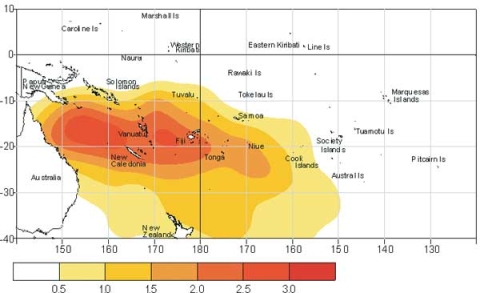Tropical Cyclones
By Stuart Burgess, Dr Jim Renwick and Dr Jim Salinger, NIWA
Three tropical cyclones so far
The tropical cyclone season is now well underway, with three cyclones having occurred so far this season. ‘Trina’ occurred from 30 November through 2 December, affecting the Southern Cook Islands. Winds gusted to 104 km/h at Rarotonga Airport, and floods resulted because of heavy rainfall. ‘Vicky’ formed on 22 December near the Northern Cooks, eventually tracking south between the Southern Cooks and French Polynesia on the 28th.
‘Waka’ was the latest and was very destructive, developing northwest of Samoa at 11°S 174°W on 29 December. Waka reached hurricane force (with estimated maximum sustained winds of 185 km/h) as it tracked south. Mean wind speeds reached 158 km/h at Niuafoo’u in Northern Tonga at 1800 UTC 30 December, with mean sea level pressure as low as 976 hPa.. This was the worst cyclone to hit the northern islands of Vava'u and Niuatoputapu in recent times, destroying 300 houses and six schools. Trees were uprooted and electricity and telecommunications cut. It also wiped out crops and affected water supplies. Fortunately no lives were lost.
We are now in the usual period of peak tropical cyclone occurrence for the Southwest Pacific, with an average of three tropical cyclones in January, two in February, two in March, and one in April, for the whole region in seasons similar to the present. On average, the highest frequencies occurred over the Coral Sea east to Fiji, including Vanuatu and New Caledonia.
The cyclone occurrence diagram and table (below) show the average number of tropical cyclones that passed near each island group in the Southwest Pacific when ENSO conditions were neutral during the January through April period. For the remainder of this season the chances of tropical cyclone activity are average or slightly lower than normal for much of the Southwest Pacific. The exceptions are Fiji and the Coral Sea where chances are slightly higher than average.

Tropical cyclone occurrence, neutral January-April periods, 1970–2001 Average Number of tropical cyclones
Major tropical cyclones bring extremes of wind, rainfall and sea surges, resulting in river and coastal flooding, landslides, and extensive damage to crops, trees, houses, power lines, ports and roads. Many lives can be lost. For a small South Pacific island country the whole economy can be severely affected. Individual tropical cyclones are, however, rather unpredictable; so most South Pacific islands are exposed to some degree of risk every year and must be always prepared.
The following table shows the average number of tropical cyclones passing near the main island groups of the Southwest Pacific over the January through April period (based on 31 years of data, and for tropical cyclones having mean wind speeds over 34 knots*).
| Area | Average for all years | Average for all Neutral ENSO years | Comments |
|---|---|---|---|
| S. Papua-New Guinea | 0.4 | 0.5 | Average |
| Soloman Islands | 1.0 | 1.0 | Average |
| Tuvalu | 0.8 | 0.8 | Average |
| Tonga | 1.6 | 1.8 | Average |
| New Caledonia | 2.5 | 2.2 | Below average |
| Vanuatu | 2.7 | 2.4 | Below average |
| Fiji | 1.9 | 2.2 | Above average |
| Wallis and Futuna | 1.4 | 1.1 | Below average |
| Samoa | 1.1 | 0.8 | Below average |
| Tokelau | 0.5 | 0.2 | Below average |
| Niue | 1.4 | 1.6 | Average |
| Southern Cook Islands | 1.2 | 1.0 | Average |
| Northern Cook Islands | 0.6 | 0.3 | Below average |
| Society Islands/Tahiti | 0.5 | 0.3 | Average |
| Austral Islands | 0.6 | 0.3 | Below average |
| Northern New Zealand | 0.9 | 1.0 | Average |
*For the southwest Pacific, “tropical cyclone” is a tropical low-pressure system intense enough to produce sustained gale force winds (at least 34 knots or 63 km/h). A “severe tropical cyclone” produces sustained hurricane force winds (at least 64 knots or 118 km/h), and corresponds to the hurricanes or typhoons of other parts of the world.
In the French language, the term "Cyclone tropicaux" refers to the hurricane phase (64 knots or 118 km per hour or more) but the “Island Climate Update” publication follows the English language definition of “Tropical cyclone” as defined in the World Meteorological Organisation Tropical Cyclone Operational Plan for the South Pacific and South-East Indian Ocean as follows “A non-frontal cyclone of synoptic scale developing over tropical waters and having a definite organised wind circulation with maximum 10-minute average wind speed of 34 knots (63 km per hour) or greater”.
The February issue of the ICU will provide an update on information relating to any occurrences of tropical cyclones in our forecast region of the Southwest Pacific.
